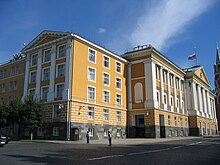Presidium of the USSR Supreme Soviet
|
Presidium of the Supreme Soviet Президиум Верховного Совета |
|
|---|---|
| collective head of state | |
 |
|
| History | |
| Established | 1938 |
| Disbanded | 1991 |
| Preceded by | Central Executive Committee of the Soviet Union |
| Succeeded by | President of the USSR |
| Seats | 37 |
| Elections | |
| Election by joint session of both houses of the Supreme Soviet | |
| Meeting place | |
 |
|
| Kremlin Presidium, Moscow Kremlin | |
The Presidium of the Supreme Soviet (Russian: Президиум Верховного Совета or Prezidium Verkhovnogo Soveta) was a Soviet governmental institution – a permanent body of the Supreme Soviets (parliaments). This body was of the all-Union level (Presidium of the Supreme Soviet of the Soviet Union), as well as in all Soviet republics (e.g., Presidium of the Supreme Soviet of the Byelorussian SSR) and autonomous republics. Structure and functions of the presidiums in these republics were virtually identical. The presidiums were elected by the Supreme Soviet to act on its behalf while the soviet was not in session. Under the 1936 and 1977 Soviet Constitution the Presidium of the Supreme Soviet served as the collective head of state of the Soviet Union.
Its building, situated inside the Moscow Kremlin, was appropriately named the Kremlin Presidium.
The Presidium of the Supreme Soviet was elected by the Supreme Soviet of the USSR at a joint session of both chambers at the first session of each following convocation. The deputies of the Presidium were appointed for the duration of the term of office of the Supreme Soviet. The Presidium of the Supreme Soviet of the USSR consisted of a chairman, a first vice-chairman (since 1977), his 15 deputies (one from each republic of the Soviet Union), a secretary, and 20 members. The Presidium was accountable to the Supreme Soviet of the USSR for all its activities.
...
Wikipedia
